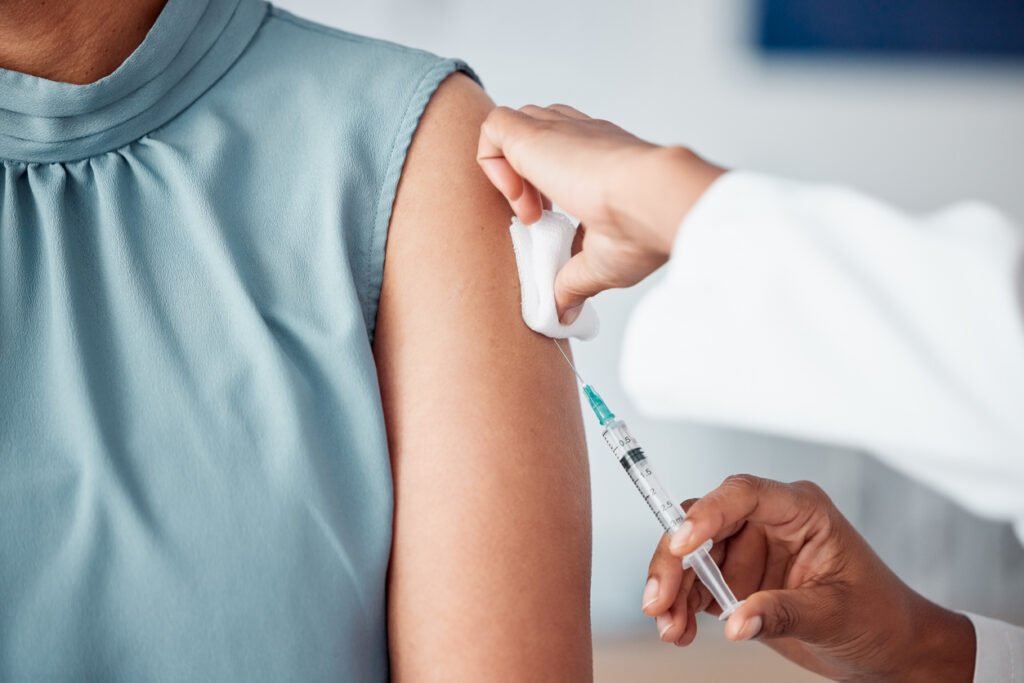Vaccines Teach Your Body to Recognize Invaders

At its core, a vaccine is like a training session for your immune system. Instead of waiting for a dangerous infection to strike, vaccines introduce a harmless piece of a virus or bacteria — or something that mimics it to your body ahead of time. This gives your immune cells a chance to study the invader without facing a real threat.
Scientists who study immunology explain that once your immune system sees this harmless version, it starts preparing a defense. It identifies what the invader looks like, builds a molecular “wanted poster,” and readies its forces for the day the real thing shows up. Thanks to this head start, your body can react faster and stronger if you are ever exposed to the actual disease, often stopping it before it can even make you sick.
The First Responders Are Your Immune Cells
When you get a vaccine, the first players to show up are the cells of your innate immune system. These are the rapid responders — cells like macrophages and dendritic cells that rush to the injection site to assess the situation. They do not recognize the exact invader yet, but they know something foreign has entered the body.
These first responders grab pieces of the vaccine material and carry it to your lymph nodes, where the real magic starts to happen. Think of them as couriers, delivering critical information to the parts of the immune system that specialize in building targeted defenses. Their quick reaction kicks off a series of steps that eventually leads to the creation of specialized immune cells designed specifically to neutralize that particular virus or bacteria.
B Cells Build Custom Weapons
Inside your lymph nodes, a special type of immune cell called a B cell starts going to work. B cells are like the body’s weapons manufacturers. When they are shown a piece of the invader — called an antigen — they start creating antibodies, which are custom-built proteins designed to latch onto that specific pathogen.
Researchers in vaccine science emphasize that these antibodies act like guided missiles. They recognize, bind to, and neutralize the invader before it can harm your cells. After vaccination, your body keeps some of these antibodies circulating for a while, giving you immediate protection. In many cases, booster doses are given later to remind your B cells of the invader and keep those protective antibodies at strong levels.
T Cells Remember and Destroy
While B cells focus on making antibodies, T cells handle another important job: destroying infected cells. Some T cells, called helper T cells, boost the work of B cells, while others, known as killer T cells, seek out and destroy cells that have been taken over by a virus.
Immunologists explain that vaccines also train T cells to recognize infected cells early and act swiftly to eliminate them. This two-pronged approach — neutralizing the pathogen and destroying infected cells — makes your immune defense incredibly powerful. Once T cells are trained, they stay in your body long-term, ready to leap into action if the real virus or bacteria ever comes calling.
Memory Cells Are the Secret to Long-Term Protection
After the initial training session is over, your immune system does not just forget what it learned. It creates memory cells — long-lived B and T cells that stay quietly in your body for years, sometimes even for life. These memory cells are like elite guards, constantly scanning your body for signs of a past enemy.
Scientists explain that memory cells are the reason some vaccines, like the ones for measles or polio, offer lifelong protection after just a few doses. If the same pathogen ever tries to invade again, these cells recognize it instantly and trigger a faster, stronger immune response. In many cases, the infection is stopped so quickly that you never even realize you were exposed at all. It is one of the most remarkable features of how vaccines work, offering lasting security with just a small initial lesson.
Booster Shots Keep Your Defenses Sharp

Over time, the number of circulating antibodies from a vaccine can fade, especially if your body does not encounter the real disease often. That is where booster shots come in. Boosters are additional doses of a vaccine given after the initial series to “remind” your immune system about the threat and sharpen its memory.
Healthcare experts explain that boosters can bring your antibody levels back up and refresh your immune memory cells. It is similar to reviewing material before an important test, even if you learned it once, revisiting it ensures you stay sharp. For some diseases like tetanus, boosters are recommended every 10 years, while others, like flu vaccines, are updated annually to match new virus strains. Boosters are a crucial part of keeping your vaccine protection strong and reliable over a lifetime.
Not All Vaccines Use the Same Strategy
While the goal of every vaccine is to prepare your immune system, they do not all go about it in the same way. Some vaccines use inactivated viruses that are completely dead but still recognizable to your body. Others use live but weakened versions that cannot cause serious illness. Newer vaccines, like mRNA vaccines, take a completely different route by teaching your cells how to make a harmless piece of the virus themselves, triggering an immune response.
Immunologists explain that each approach has its strengths. Live vaccines often create strong, long-lasting immunity with fewer doses, while inactivated and mRNA vaccines tend to be safer for people with weakened immune systems. Scientists choose the best vaccine design based on the disease they are targeting and the needs of the population they are trying to protect. Understanding that vaccines are tailored for different battles shows how flexible and ingenious medical science has become.
Side Effects Are a Sign Your Immune System Is Working
It is easy to worry when you feel tired, achy, or slightly feverish after getting a vaccine. But those mild side effects are actually good news. They are a sign that your immune system has noticed the vaccine and is gearing up for action. Your body is reacting the same way it would if a real infection were beginning but without the dangers of the actual disease.
Medical researchers emphasize that symptoms like soreness, fatigue, or a slight fever show that your immune defenses are activating and that cells are communicating, dividing, and creating memory. These responses usually pass quickly and leave behind a stronger, better-prepared immune system. Rather than being a warning of harm, these signs are proof that your body is doing exactly what it should: building its defenses to keep you safe in the future.
Herd Immunity Starts With Individual Immunity
When you get vaccinated, you are not just protecting yourself. You are also helping shield people around you, especially those who cannot be vaccinated due to age, allergies, or medical conditions. This ripple effect is called herd immunity, and it is one of the most powerful ways vaccines help entire communities stay safe.
Public health experts explain that when enough people in a community are immune to a disease, it has nowhere to spread. Even if a few cases appear, outbreaks are rare and short-lived. Herd immunity protects the most vulnerable among us, newborns, the elderly, or people with weakened immune systems, who rely on others to block the path of infection. Every vaccinated person becomes a barrier in the chain of transmission, turning individual protection into a collective shield.
Vaccines Are Constantly Monitored for Safety
Once a vaccine is approved and given to the public, the work does not stop. Health agencies around the world keep monitoring vaccines closely to make sure they stay safe and effective. Systems like the Vaccine Adverse Event Reporting System (VAERS) allow doctors and patients to report any side effects, which are then carefully analyzed.
Epidemiologists highlight that this constant monitoring helps catch even rare problems quickly and ensures vaccines meet the highest safety standards. If any issues arise, recommendations can be adjusted based on real-world data. This ongoing vigilance is part of what makes vaccination one of the safest and most rigorously overseen medical practices in the world. It is a partnership between science, medicine, and public trust that continues long after the first dose is given.
New Technologies Are Making Vaccines Faster Than Ever
The COVID-19 pandemic showed the world just how quickly science can move when needed. Thanks to decades of research on mRNA, viral vectors, and synthetic biology, scientists were able to create, test, and distribute vaccines in record time without skipping crucial safety steps.
Biotechnology experts point out that these new platforms allow for faster updates and more precise targeting. Instead of growing viruses in eggs or cultures for months, researchers can now design vaccines at the molecular level using genetic code. This not only speeds up the response to new threats but also opens possibilities for vaccines against diseases that have long eluded traditional methods. The future of vaccines looks faster, smarter, and more adaptable, ready to meet the next global health challenge head-on.
Vaccines Are a Triumph of Human Ingenuity

At the heart of every vaccine is a simple but profound idea: that knowledge and preparation can save lives. Vaccines turn the invisible battles inside our bodies into victories won without suffering. They prevent diseases that once wiped out millions, allowing generations to grow up healthy and strong without even remembering the threats they escaped.
Scientists, doctors, and researchers have worked for centuries to understand the mysteries of immunity and to turn that understanding into powerful tools. Every shot given is a small celebration of human curiosity, compassion, and resilience. When you get vaccinated, you are not just protecting yourself. You are participating in one of humanity’s greatest achievements, using the power of science to rewrite the future in favor of life.
